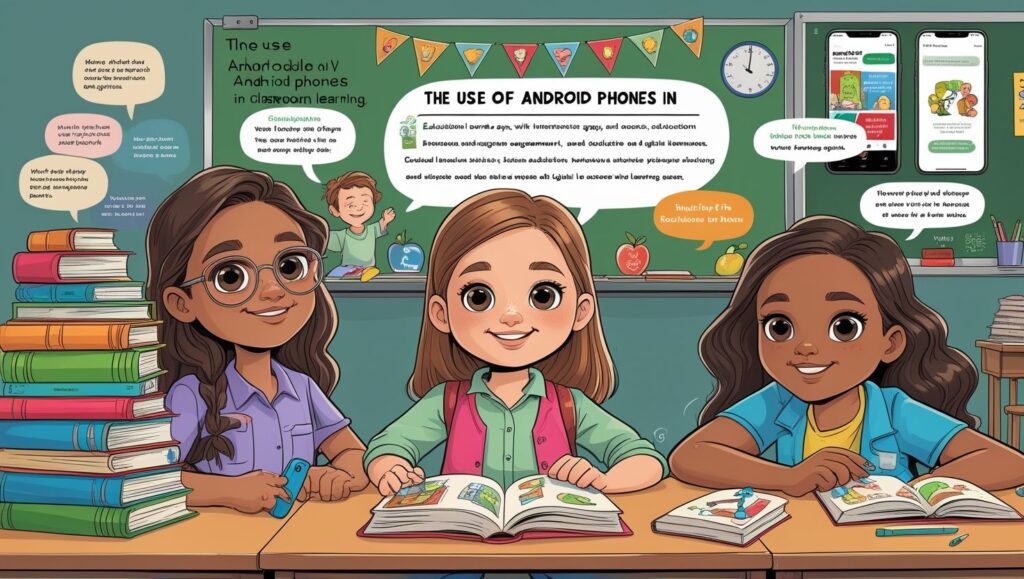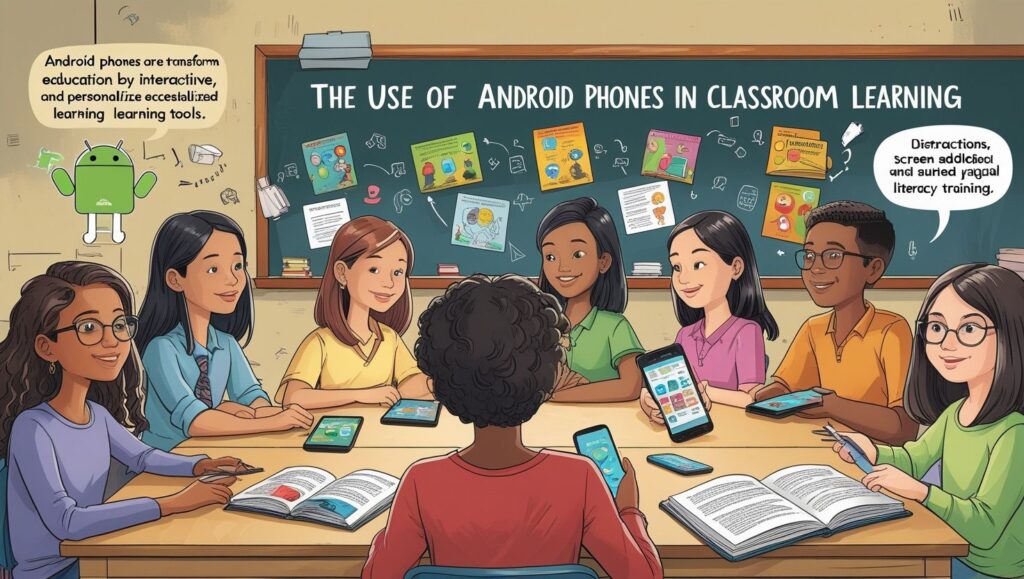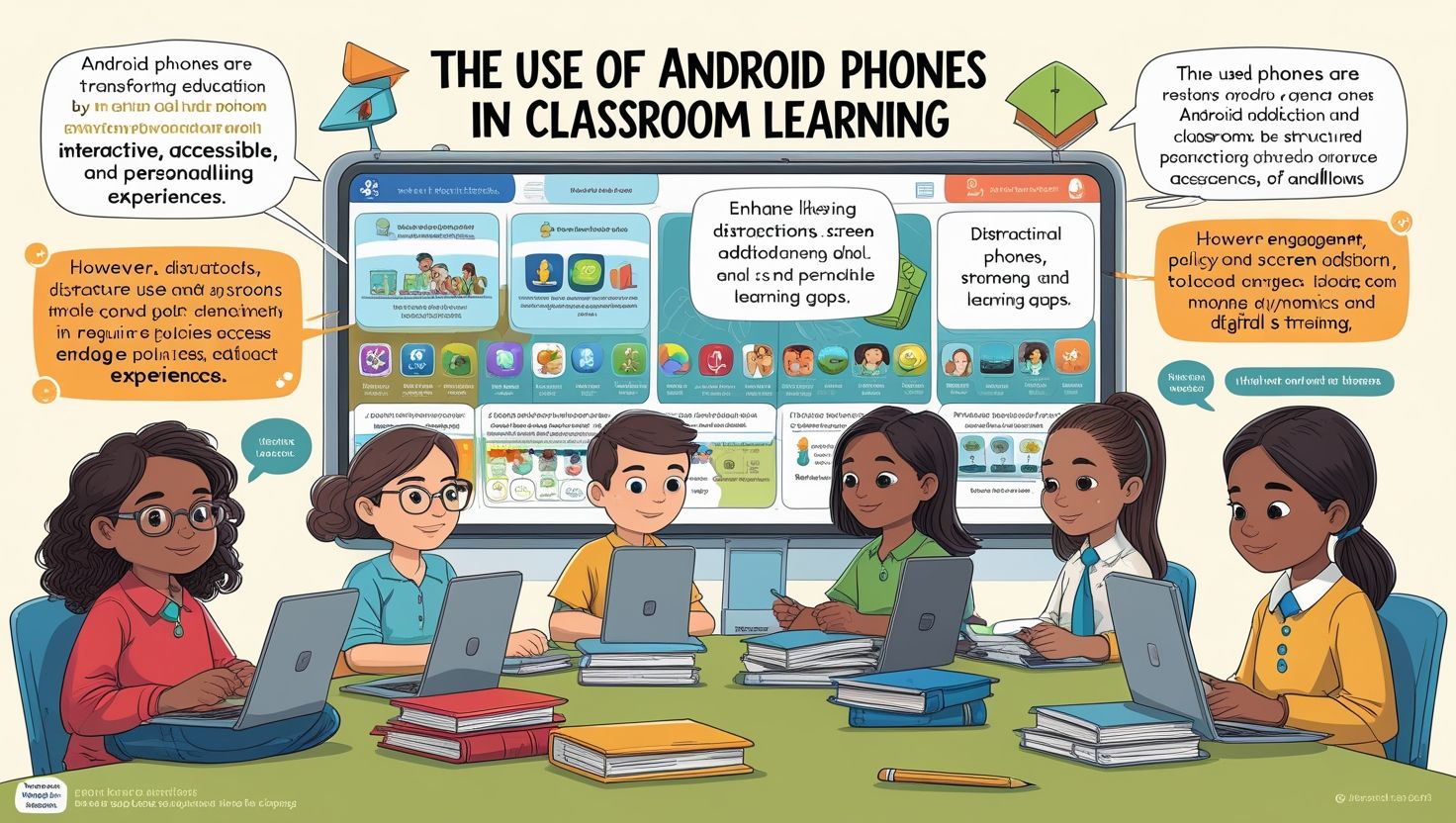Introduction
The Use of Android Phones in Classroom Learning, The integration of technology in education has transformed traditional teaching methods, with Android smartphones playing a pivotal role in modern classrooms. As versatile, portable, and cost-effective devices, they provide students and educators with access to a wealth of digital resources, interactive learning tools, and real-time collaboration platforms. The use of Android phones in education enhances engagement, personalizes learning, and bridges gaps in accessibility, especially in remote or underprivileged areas.
However, this shift also raises concerns about distractions, screen addiction, and data security. Despite these challenges, the benefits of Android phones in learning—such as instant access to e-books, educational apps, and AI-driven tutoring—outweigh the drawbacks when managed effectively. Schools and policymakers must establish guidelines to maximize educational benefits while minimizing misuse.
This article explores the advantages, challenges, and future potential of Android phones in classroom learning, analyzing their impact on student performance, teacher efficiency, and the overall education system. By understanding their role, educators can harness technology to create a more dynamic and inclusive learning environment.
Advantages of Android Phones in Classroom Learning
Android phones offer numerous benefits in education, making learning more interactive and accessible. One key advantage is instant access to digital resources, including e-books, research articles, and educational videos. Students no longer rely solely on textbooks, as smartphones provide up-to-date information at their fingertips.
Another benefit is personalized learning. Educational apps like Khan Academy, Duolingo, and Google Classroom adapt to individual learning speeds, helping students grasp concepts at their own pace. Teachers can also use analytics from these apps to identify struggling students and provide targeted support.
Additionally, Android phones facilitate collaborative learning. Tools like Google Docs, Zoom, and Microsoft Teams enable group projects and virtual discussions, fostering teamwork even outside the classroom. Gamified learning apps also increase student engagement by turning lessons into interactive challenges.
Lastly, Android phones support distance learning, ensuring education continuity during disruptions like pandemics or natural disasters. With affordable internet and offline learning apps, students in remote areas can access quality education, reducing educational inequality.

Educational Apps and Tools for Android Phones
A wide range of educational apps enhances learning through Android phones. Learning Management Systems (LMS) like Google Classroom and Moodle allow teachers to distribute assignments, track progress, and provide feedback efficiently. These platforms streamline classroom management and reduce paperwork.
Interactive learning apps such as Kahoot!, Quizlet, and Photomath make studying engaging. Kahoot! turns quizzes into competitive games, while Photomath helps students solve math problems using their phone’s camera. Such tools make complex subjects more approachable.
Language learning apps like Duolingo and Babbel use AI to personalize lessons, helping students master new languages through gamification. Similarly, coding apps like SoloLearn and Grasshopper introduce programming concepts in an interactive way, preparing students for tech-driven careers.
For STEM education, apps like NASA Visualization Explorer and Pocket Physics provide immersive learning experiences. Augmented Reality (AR) apps like Google Expeditions allow virtual field trips, enhancing geography and history lessons.
By integrating these apps, Android phones transform into powerful learning tools, making education more dynamic and accessible for all students.
Challenges of Using Android Phones in Classrooms
Despite their benefits, Android phones in classrooms present several challenges. Distraction is a major concern, as students may misuse devices for social media, gaming, or texting instead of learning. This reduces focus and academic performance.
Another issue is cybersecurity risks. Schools must ensure student data privacy, as malicious apps or phishing attacks can compromise sensitive information. Educators need to implement strict security measures and teach digital literacy to prevent breaches.
Screen addiction is also a growing problem. Excessive phone use can lead to eye strain, sleep disorders, and reduced physical activity. Schools must enforce screen-time limits and encourage offline learning activities.
Additionally, inequality in access persists. Not all students can afford high-end Android phones or stable internet, creating a digital divide. Governments and institutions must provide subsidized devices and free Wi-Fi to ensure equal opportunities.
Lastly, teacher resistance can hinder adoption. Some educators prefer traditional methods and may lack training in digital tools. Professional development programs are essential to help teachers integrate smartphones effectively into lessons.

Strategies for Effective Implementation
To maximize the benefits of Android phones in classrooms, schools should adopt structured implementation strategies. Clear usage policies must be established, defining when and how phones should be used for learning. This minimizes distractions while promoting productive use.
Teacher training programs are crucial. Educators should receive workshops on educational apps, digital security, and classroom management techniques involving smartphones. This ensures they can guide students effectively.
Parental involvement is another key factor. Schools should educate parents on monitoring screen time and encouraging responsible phone use at home. Collaboration between teachers and parents fosters a balanced approach to digital learning.
Offline-compatible apps should be prioritized to support students with limited internet access. Apps like Khan Academy Lite allow learning without constant connectivity, reducing disparities.
Lastly, gamification and rewards can motivate students. Teachers can use apps like ClassDojo to award points for participation, encouraging disciplined and engaged learning.
By implementing these strategies, schools can create a structured, productive environment where Android phones enhance rather than disrupt education.
Future of Android Phones in Education
The future of Android phones in education looks promising, with emerging technologies enhancing their role. Artificial Intelligence (AI) will personalize learning further, offering real-time feedback and adaptive lesson plans based on student performance.
Augmented Reality (AR) and Virtual Reality (VR) will revolutionize experiential learning. Imagine history students exploring ancient civilizations through AR simulations or medical students practicing virtual dissections—all via their smartphones.
5G connectivity will enable seamless streaming of high-quality educational content, making cloud-based learning more efficient. Remote students will benefit from lag-free virtual classrooms and real-time collaboration.
Blockchain technology may secure academic records, ensuring tamper-proof certifications and digital badges stored on students’ devices.
Additionally, foldable and affordable Android phones will make advanced learning tools accessible to more students worldwide. Governments and tech companies must collaborate to subsidize devices for underprivileged learners.
As Android phones evolve, they will become indispensable in education, bridging gaps and creating immersive, interactive learning experiences for future generations.
Conclusion
Android phones have undeniably transformed classroom learning, offering accessibility, interactivity, and personalized education. From digital textbooks to AI-driven tutoring, these devices empower students and teachers alike.
However, challenges like distractions, cybersecurity risks, and unequal access must be addressed through structured policies, teacher training, and government initiatives. By implementing responsible usage guidelines, schools can harness the full potential of smartphones in education.
Looking ahead, advancements in AI, AR/VR, and 5G will further integrate Android phones into learning, making education more immersive and inclusive. The key lies in balancing innovation with discipline, ensuring technology enhances rather than hinders learning.
As we move toward a digitally driven future, Android phones will continue to play a vital role in shaping modern education. By embracing their benefits while mitigating risks, educators can create a dynamic, equitable, and engaging learning environment for students worldwide.


paito togel
Mecidiyeköy su kaçağı tespiti Salon zeminindeki su kaçağını bulmak için geldiklerinde çok düzenli çalıştılar. Parkelere zarar vermeden sorunu çözdüler. Ali R. https://www.biteyourconsole.net/author/kacak/
hello there and thanks on your information ? I?ve certainly picked up something new from proper here. I did alternatively expertise some technical issues the usage of this website, as I skilled to reload the web site a lot of occasions prior to I may just get it to load correctly. I had been wondering in case your web host is OK? Not that I’m complaining, however slow loading circumstances times will sometimes impact your placement in google and could harm your high-quality score if advertising and ***********|advertising|advertising|advertising and *********** with Adwords. Anyway I am adding this RSS to my email and can look out for a lot extra of your respective exciting content. Make sure you replace this again soon..
Do you mind if I quote a few of your posts as long as I provide credit and sources back to your website? My blog site is in the exact same niche as yours and my users would genuinely benefit from some of the information you provide here. Please let me know if this okay with you. Thanks!
I’ve learned a few important things as a result of your post. I will also like to convey that there can be situation in which you will have a loan and do not need a cosigner such as a Federal Student Aid Loan. However, if you are getting a loan through a common bank then you need to be prepared to have a co-signer ready to help you. The lenders can base their own decision over a few factors but the main one will be your credit history. There are some financial institutions that will also look at your work history and determine based on this but in most cases it will hinge on your scores.
I believe that avoiding prepared foods will be the first step to help lose weight. They may taste great, but prepared foods contain very little nutritional value, making you take more in order to have enough power to get throughout the day. If you are constantly ingesting these foods, transferring to grain and other complex carbohydrates will aid you to have more power while eating less. Great blog post.
I’m curious to find out what blog system you happen to be using? I’m experiencing some minor security issues with my latest blog and I’d like to find something more safeguarded. Do you have any solutions?
Simply desire to say your article is as astounding. The clearness in your post is simply spectacular and i could assume you are an expert on this subject. Fine with your permission allow me to grab your RSS feed to keep up to date with forthcoming post. Thanks a million and please continue the rewarding work.
It?s actually a cool and useful piece of info. I am happy that you simply shared this useful information with us. Please keep us informed like this. Thanks for sharing.
What I have generally told people today is that while searching for a good on-line electronics retail outlet, there are a few variables that you have to remember to consider. First and foremost, you want to make sure to find a reputable and in addition, reliable retail store that has received great reviews and scores from other individuals and market sector people. This will ensure you are dealing with a well-known store that can offer good services and support to the patrons. Many thanks for sharing your notions on this blog site.
Nice blog here! Also your website loads up very fast! What web host are you using? Can I get your affiliate link to your host? I wish my web site loaded up as fast as yours lol
deniz kucukkay
mehmet emre dinç
esteworld
medhair clinic
huseyin kandulu
dr basat
basat
ışık diş
şaban
terziler
salih emre
yelken
dr yelken
ahd clinic
adem köse
adem köse
Its like you read my mind! You seem to know a lot about this, like you wrote the book in it or something. I think that you could do with some pics to drive the message home a little bit, but instead of that, this is magnificent blog. A great read. I will definitely be back.
aslı tarcan global
adem köse
medhair cinici
aslı tarcan global
It?s actually a great and helpful piece of info. I?m glad that you shared this helpful info with us. Please keep us up to date like this. Thanks for sharing.
affordablecanvaspaintings.com.au is Australia Popular Online 100 percent Handmade Art Store. We deliver Budget Handmade Canvas Paintings, Abstract Art, Oil Paintings, Artwork Sale, Acrylic Wall Art Paintings, Custom Art, Oil Portraits, Pet Paintings, Building Paintings etc. 1000+ Designs To Choose From, Highly Experienced Artists team, Up-to 50 percent OFF SALE and FREE Delivery Australia, Sydney, Melbourne, Brisbane, Adelaide, Hobart and all regional areas. We ship worldwide international locations. Order Online Your Handmade Art Today.
aslı tarcan global
terziler
I’m not sure exactly why but this website is loading incredibly slow for me. Is anyone else having this problem or is it a problem on my end? I’ll check back later on and see if the problem still exists.
aslı tarcan global
doktor kbb
This design is wicked! You obviously know how to keep a reader entertained. Between your wit and your videos, I was almost moved to start my own blog (well, almost…HaHa!) Fantastic job. I really loved what you had to say, and more than that, how you presented it. Too cool!
Do you have a spam issue on this website; I also am a blogger, and I was wanting to know your situation; many of us have created some nice practices and we are looking to swap techniques with others, be sure to shoot me an email if interested.
guncel ozturk
I would also love to add that if you do not already have an insurance policy or perhaps you do not take part in any group insurance, chances are you’ll well make use of seeking the aid of a health insurance professional. Self-employed or those that have medical conditions generally seek the help of the health insurance broker. Thanks for your writing.
I’m in awe of the author’s talent to make complex concepts approachable to readers of all backgrounds. This article is a testament to his expertise and dedication to providing useful insights. Thank you, author, for creating such an compelling and illuminating piece. It has been an unforgettable experience to read!
One other issue is when you are in a scenario where you do not possess a co-signer then you may want to try to wear out all of your school funding options. You could find many grants or loans and other grants that will offer you funding to aid with education expenses. Many thanks for the post.
I have really learned newer and more effective things through your web site. One other thing I’d really like to say is that often newer personal computer operating systems tend to allow a lot more memory for use, but they furthermore demand more memory simply to operate. If people’s computer cannot handle extra memory as well as the newest computer software requires that ram increase, it can be the time to buy a new Personal computer. Thanks
guncel ozturk
I’m impressed by the quality of this content! The author has obviously put a huge amount of effort into researching and arranging the information. It’s inspiring to come across an article that not only offers useful information but also keeps the readers engaged from start to finish. Hats off to her for creating such a remarkable piece!
Hello my loved one! I wish to say that this article is amazing, great written and include almost all important infos. I would like to see extra posts like this .